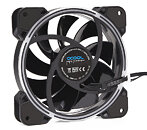Thursday, April 23rd 2020

Alphacool Intros Eiszyklon Aurora LUX PRO 2 Digital RGB Fan
Alphacool today introduced the Eiszyklon Aurora LUX PRO 2 D-RGB case fan, debuting with a 120 mm model. A new generation of the original Eiszyklon fans the company launched in mid-2018, the LUX PRO 2 is optimized for both case ventilation and use with radiators. It features hydraulic bearings rated for 40,000 hours of use. It takes in 4-pin PWM input for its main function, and spins between 700 to 2,000 RPM, pushing up to 61.5 CFM of air, with 2.0 mm H2O static pressure. Depending on the speed, the noise output is rated between 21.5 to 33.8 dBA. The lighting system of these fans includes a silicone diffuser located along the frame, which takes in a 3-pin (5 V) ARGB connection. The mounts of fan feature rubber vibration dampeners. Available now, the Alphacool Eiszyklon Aurora LUX PRO 2 Digital RGB is priced at 16.95€ a piece (including VAT).




1 Comment on Alphacool Intros Eiszyklon Aurora LUX PRO 2 Digital RGB Fan
They are a watercooling company that should prioritise radiator fans. I have some great static-pressure fans from Coolermaster and Arctic that are purpose-built for quiet, efficient performance at the sort of static pressures a radiator demands.
This is clearly a general purpose design that can be used for airflow or static pressure - small blades with steep angle of attack and obvious gaps between the trailing edge of one blade and the leading edge of the next. This gives a venturi effect that is great for magnifying airflow in situations with unrestrictive air paths, or coolers/radiators with very open fin stacks.and therefore a compromise when used with a radiator or dense heatsink that demands performance at much higher static pressures. Real static pressure fans have the opposite; Shallow angles of attack and larger blades where the leading edge of one blade overlaps the trailing edge of the blade ahead of it.
No, I'm not a fan blade expert but I do have a masters degree that included computational fluid dynamics so I'm not talking out of my ass here either.